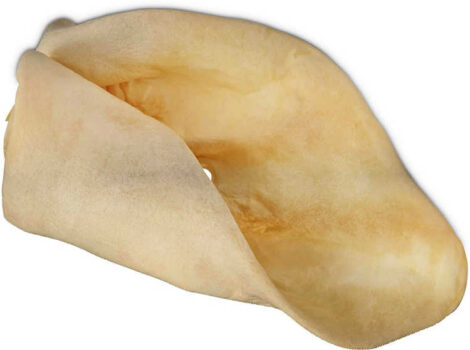Do you have a large dog and find that normal sized treats are not more than a mouthful for him? Or do you have a dog which has a big appetite? Are you looking for a natural treat which your dog is sure to love? Look no further — cow ears for dogs might be for you!
In this article we will look at where cow ears come from, how they’re made, what benefits they have and whether or not they’re safe for your dog.
Cow ears are a great option for an occasional treat, which offers health benefits for the teeth and joints.
They provide a moderate amount of chewing time, and for most dogs, don’t pose any risk of ill-health.
However, cow ears can be sourced from a variety of places with varying degrees of animal welfare, as well as processed in very different ways, so it is important to investigate each individual product before buying.
Cow ears, as the name suggests, come from cows. They are a by-product of the beef industry, and processed after slaughter to create delicious chews for dogs. They are commonly chosen as larger alternatives for pig ears, as they are at least 50% bigger, and sometimes double the size! Don’t be fooled that a larger size means more chewing time though. On average it will take between 20 minutes and a couple of hours for a dog to finish a cow ear.
Naturally, cow ears are hairy, so they have to go through a process to get to the point at which they are edible. Firstly, the hair is removed, then they are disinfected. This is usually done with a mixture of sodium hypochlorite, but different companies will use different disinfectant solutions. Next they are dried. This can be through baking or dehydrating. Finally, some cow ears are also irradiated before they are packaged, which kills off bacteria such as Salmonella.
Due to the differences in the processing stage between companies, cow ears can look very different depending on where you buy them from. They could be dried relatively hard or slightly puffed up, and they can range in colour from white (most likely irradiated) to brown.
Cow ears are generally considered a better alternative to rawhide chews because they are more easy for your dog to digest and don’t tend to be as tough. Because rawhides are harder and tougher than cow ears, they are also more likely to cause broken teeth and mouth damage.
Pros & Cons: What I Like Best (And Least) About Cow Ears For Dogs
Because cow ears dog chews look so much like rawhide, at first I thought they were considered rawhide chews. But they’re not rawhide at all!
Rawhide is the inner layer of a cow’s hide or a horse’s hide — it does not dissolve in a dog’s stomach. Instead, it swells up in your dog’s belly — forcing your dog to pass any rawhide pieces that they’ve swallowed. (This can lead to throat blockage or bowel blockage.)
Cow ears are actually cartilage wrapped in a thin skin — there’s no splintering at all.
They’re 100% digestible.
Cow ears are high in protein and low in fat — which makes a great low-calorie dog treat.
They provide somewhat of a challenge for your dog to gnaw on and chew into pieces. (My dogs can demolish these in less than an hour sometimes though.)
NOTE: Even though they are easily digestible (and yes, my dogs have swallowed the larger pieces on several occasions), I generally don’t let my dogs eat any really large pieces that they have chewed off of cow ears.
Pig ears are:
My Experience Giving Dogs Cow Ear Dog Chews

HOW LONG IT LASTS: Hours
BEST FOR: Light chewers, Small dogs, Senior dogs
TIP: Cow ears get soft as your dog chews on them. Once soft, they’re relatively easy for a dog to tear pieces of it off. While they ultimately digest just fine in a dog’s tummy, I don’t let my dogs swallow any really big pieces.
MY FAVORITE BRAND(S): Pawstruck and Cadet
FAQ
Are cow ears the same as rawhide?
Are cow ears a choking hazard for dogs?
Cow’s ears carry a small risk of choking, so always remove the last chunk. Overfeeding could cause an upset tummy.
Are cow ears digestible?